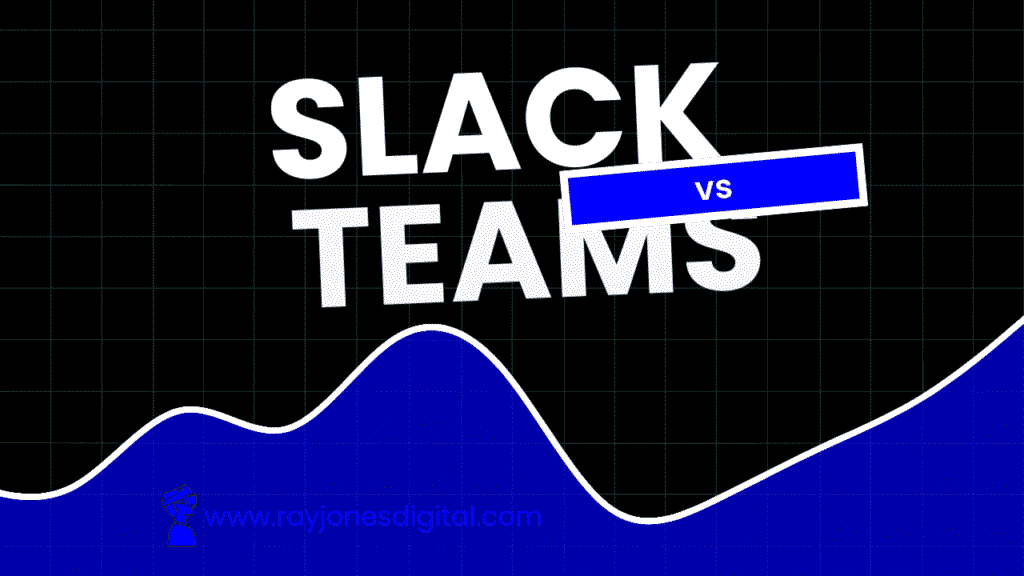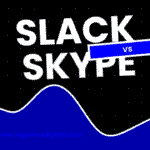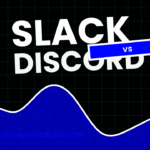
The battle for workplace communication supremacy has intensified between two major platforms: Slack, the channel-based messaging pioneer, Slack vs Teams, the integrated collaboration suite. Both platforms promise to transform how teams communicate, but they approach this challenge from different angles and serve distinct organisational needs.
Slack revolutionised workplace communication with its intuitive channel structure and extensive app integrations. Teams countered with deep Microsoft 365 integration and comprehensive meeting capabilities. Both platforms have evolved significantly, adding features and refining their approaches to team collaboration.
This comprehensive comparison examines the core strengths, limitations, and ideal use cases for each platform. We’ll explore their communication features, integration capabilities, pricing structures, and real-world performance to help you determine which solution best fits your team’s requirements.
Understanding the Fundamentals
What is Slack?
Slack launched in 2013 as a team communication platform built around the concept of channels—organised spaces for specific topics, projects, or teams. The platform gained rapid adoption amongst tech companies and startups before expanding into enterprise markets.
The service operates on a “channels and direct messages” model, allowing teams to organise conversations by topic whilst maintaining the flexibility for private discussions. This structure reduces email dependency and creates searchable knowledge bases for team information.
Slack’s strength lies in its simplicity and focus on communication. The platform excels at creating organised, searchable conversations that help teams stay aligned without overwhelming users with excessive features.
What is Microsoft Teams?
Microsoft Teams entered the market in 2017 as part of the broader Microsoft 365 ecosystem. Rather than focusing solely on chat, Teams positions itself as a comprehensive collaboration hub integrating chat, video calls, file sharing, and application access.
The platform leverages Microsoft’s existing enterprise relationships and Office 365 adoption to provide seamless integration with familiar productivity tools. This approach appeals to organisations already invested in Microsoft’s ecosystem.
Teams emphasises unified collaboration over specialised communication. The platform aims to replace multiple tools with a single integrated solution, reducing app switching and centralising team workflows.
Core Communication Features
Messaging and Channels
Slack pioneered the channel-based communication model that has become standard across team messaging platforms. Users can create public channels for team-wide discussions, private channels for sensitive topics, and direct messages for one-on-one conversations.
The platform includes advanced messaging features like threaded conversations, message reactions, and custom emoji. These elements create engaging communication experiences that encourage participation and reduce formal communication barriers.
Slack’s search functionality excels at finding historical conversations and shared files. The platform indexes all messages and files, creating a searchable knowledge base that preserves institutional knowledge.
Teams adopts a similar channel structure but integrates it more deeply with Microsoft’s productivity suite. Channels can include integrated tabs for Excel files, SharePoint documents, and third-party applications, creating contextual workspaces around specific projects.
The platform includes comprehensive formatting options and @mention capabilities that integrate with broader Microsoft 365 user directories. This integration provides seamless communication across organisational boundaries.
Winner: Slack – Superior messaging experience with more intuitive channel management and better search capabilities.
Video Calling and Meetings
Slack provides basic video calling capabilities suitable for small team meetings and one-on-one conversations. The platform includes screen sharing and basic meeting controls, though advanced features require higher-tier subscriptions.
Recent updates have improved Slack’s video capabilities, including features like virtual backgrounds and improved audio quality. However, the platform still positions video as a secondary feature rather than a core strength.
Integration with external video platforms like Zoom provides access to advanced meeting features, though this requires additional subscriptions and creates workflow complexity.
Teams excels at video communication with enterprise-grade meeting capabilities built into the core platform. The service includes features like meeting recording, live captions, and advanced presenter controls.
The platform supports large meetings with up to 1,000 participants and includes webinar capabilities for external audiences. Integration with Outlook calendar provides seamless meeting scheduling and management.
Teams’ video quality and reliability often exceed Slack’s native capabilities, particularly for larger meetings and more complex presentation requirements.
Winner: Teams – Superior video meeting capabilities with enterprise-grade features and excellent integration with Microsoft’s productivity ecosystem.
File Sharing and Collaboration
Slack provides straightforward file sharing with support for various file types and sizes. The platform includes basic collaboration features like file comments and sharing permissions, though advanced document collaboration requires external applications.
Integration with cloud storage services like Google Drive and Dropbox provides access to external files, though this creates dependencies on multiple platforms and can complicate permission management.
The platform’s strength lies in making shared files discoverable through search and channel organisation, creating accessible repositories of team resources.
Teams integrates deeply with SharePoint and OneDrive, providing enterprise-grade file management and collaboration capabilities. Users can edit Office documents directly within the Teams interface without switching applications.
The platform includes advanced collaboration features like real-time document editing, version control, and comprehensive permission management. These capabilities create seamless workflows for document-heavy organisations.
File sharing in Teams feels more natural for organisations already using Microsoft productivity tools, with automatic syncing and familiar interface elements.
Winner: Teams – Superior file collaboration capabilities with seamless Microsoft Office integration and enterprise-grade document management.
Integration Capabilities
Third-Party App Ecosystem
Slack built its reputation on extensive third-party integrations, with over 2,000 apps available in the Slack App Directory. These integrations cover project management, customer support, development tools, and numerous other business functions.
The platform’s API allows custom integrations and workflow automation, enabling teams to create tailored solutions for specific business needs. This flexibility has made Slack popular amongst technology companies and organisations with unique workflow requirements.
Popular integrations include Trello, Asana, GitHub, and Salesforce, creating unified workflows that reduce app switching and improve productivity.
Teams offers growing integration options, though the selection remains smaller than Slack’s extensive ecosystem. The platform focuses on deep integration with Microsoft’s own tools whilst providing connections to popular third-party services.
The platform’s strength lies in pre-built integrations with Microsoft services like SharePoint, Power BI, and Dynamics 365. These integrations provide seamless experiences for organisations already invested in Microsoft’s ecosystem.
Third-party integration quality varies, with some apps feeling less polished than their Slack equivalents. However, the platform continues expanding its integration capabilities with regular updates.
Winner: Slack – Extensive third-party integration ecosystem with superior API capabilities and more mature app marketplace.
Microsoft 365 Integration
Slack provides integrations with Microsoft 365 applications, though these connections can feel secondary to the platform’s primary focus. Users can access shared files and calendar information, but the experience lacks the seamless integration found in Teams.
The platform works well in mixed-tool environments where teams use various productivity suites, though Microsoft-heavy organisations may find the integration limiting.
Teams provides unparalleled integration with Microsoft 365, creating unified experiences across productivity applications. Users can access Word documents, Excel spreadsheets, and PowerPoint presentations directly within Teams channels.
Calendar integration provides seamless meeting scheduling and management, with automatic Teams meeting links and unified communication experiences. This integration eliminates friction common in multi-platform environments.
The platform essentially extends Microsoft 365 functionality rather than replacing it, creating familiar experiences for users already comfortable with Microsoft’s productivity tools.
Winner: Teams – Exceptional Microsoft 365 integration creates seamless productivity experiences for organisations using Microsoft’s ecosystem.
Pricing Comparison
Slack Pricing
- Free Plan: Limited message history, 10 integrations, basic features
- Pro Plan: £5.25 per user monthly, unlimited message history, unlimited integrations
- Business+ Plan: £9.75 per user monthly, advanced security, compliance features
- Enterprise Grid: Custom pricing for large organisations with advanced governance needs
All paid plans include guest access and advanced administrative controls.
Teams Pricing
- Free Plan: Basic chat and video calling, limited file storage
- Microsoft 365 Business Basic: £4.50 per user monthly, includes web versions of Office apps
- Microsoft 365 Business Standard: £9.60 per user monthly, includes desktop Office applications
- Microsoft 365 Business Premium: £17.60 per user monthly, includes advanced security and compliance features
Teams pricing includes full Microsoft 365 productivity suite access, providing significant value for organisations requiring comprehensive productivity tools.
Winner: Teams – Better value proposition when considering included Microsoft 365 applications and productivity tools.
User Experience and Interface
Slack’s Interface
Slack provides a clean, intuitive interface designed around channel-based communication. The platform’s design emphasises simplicity and ease of use, with minimal learning curve for new users.
The interface includes customisation options like themes and notification settings, allowing users to personalise their experience. These options help accommodate different working styles and preferences.
Mobile applications provide excellent experiences with full feature parity across devices. The platform’s mobile-first design ensures consistent functionality regardless of device choice.
Teams’ Interface
Teams presents a more complex interface reflecting its comprehensive feature set. The platform includes multiple tabs and sections, which can feel overwhelming for users seeking simple communication tools.
The interface design follows Microsoft’s broader design language, creating familiar experiences for users accustomed to Office applications. This consistency reduces learning curves for existing Microsoft users.
Mobile applications provide good functionality, though the comprehensive feature set can feel cramped on smaller screens. The platform prioritises desktop experiences while maintaining mobile accessibility.
Winner: Slack – More intuitive interface design with better mobile experiences and lower learning curve for new users.
Security and Compliance
Slack Security
Slack provides enterprise-grade security features including data encryption, single sign-on integration, and compliance certifications. The platform meets requirements for most regulated industries and provides detailed audit logs.
Advanced security features like data loss prevention and advanced threat protection require higher-tier subscriptions. These features provide comprehensive protection for sensitive organisational data.
The platform’s security model focuses on data protection and access control, with regular security updates and transparent reporting on security incidents.
Teams Security
Teams leverages Microsoft’s enterprise security infrastructure, providing comprehensive protection through Azure Active Directory integration and advanced threat protection.
The platform includes advanced compliance features like legal hold, data retention policies, and regulatory compliance certifications. These capabilities support organisations with strict regulatory requirements.
Security features integrate seamlessly with broader Microsoft 365 security tools, creating unified security management across productivity applications.
Winner: Teams – Superior security capabilities with comprehensive compliance features and enterprise-grade protection.
Performance and Reliability
Slack Performance
Slack maintains excellent uptime and reliability, with robust infrastructure supporting millions of users globally. The platform handles high message volumes efficiently and provides consistent performance across different usage patterns.
The service includes comprehensive status reporting and proactive communication during service disruptions. This transparency helps organisations plan around potential issues.
Performance remains consistent across different devices and network conditions, with optimised applications for various platforms.
Teams Performance
Teams performance has improved significantly since launch, with Microsoft investing heavily in infrastructure and optimisation. The platform now handles large-scale deployments reliably, though some users report occasional performance issues during peak usage.
The service benefits from Microsoft’s global infrastructure and enterprise-grade hosting capabilities. This foundation provides strong performance for most organisational requirements.
Integration with other Microsoft services can occasionally create performance dependencies, though these issues are becoming less common with continued optim

I am Ray Jones Digital
My current occupations: a Digital Marketer, Local SEO expert, Link Builder, and WordPress SEO specialist. Shopify SEO, Ecommerce Store Management, and HTML & WordPress Developer I have been practicing the above mentioned services for more than 10 years now As an SEO expert working with your ongoing projects.



